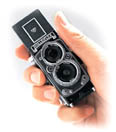
« PREVIOUS ENTRY
Simon says
NEXT ENTRY »
The computerized critic

Okay, this rocks beyond description. Rollei has just released a miniature, digital-camera version of the classic Rolleiflex 2.8 — the old-school piece of precision-tooled German engineering that revolutioned personal photography in the 1920s. Just like the original version, it has a top-down viewer: You hold the camera at waist level and peer down into the viewer, which is now, naturally, an LCD screen. As the Rollei site points out, this style has a bunch of cool psychological properties:
Why has the Rollei Twin Lens Reflex always been preferred for portraits? The camera, held at waist level, never ‘stares the model in the eye.’ People go on looking and acting naturally instead of posing for the camera. This is true for grown-ups but also goes for small children and even animals. With this type of viewfinder, you can also hold the camera very low or even place it on the ground when the shot requires that. And you don’t have to lie flat on your belly yourself.
This is brilliant: Using the ergonomics of classic design, but updating it with modern technology. One of the interesting problems about today’s digital tools is that they have a lot more flexibility in their design — maybe too much flexibility. Old-school cameras had rigid limits that helped structure them: A camera had to have a certain shape and size because it contained canisters of film and lenses that needed to physically zoom in and out. Modern digital cameras don’t have these restrictions, so you’re allowed to make them tinier and tinier. Obviously, being small is good for portability — but it means that designers lose some of the ergonomic elegance that was built into old-style cameras.
It’s the same thing with phones — one of my personal bugbears. Ever wonder why people bellow into mobile phones? It’s because the devices have been shrunk so small that they no longer feel like phones. They’re so small and flat that you might as well be holding a stapler to your head, or perhaps a TV remote. They don’t seem like phones any more; they’ve lost all sense of phone-ness. No wonder we holler and yell into them! On some subconscious level, we’re worried they’re not really listening to us.
In contrast, when you pick up an old-school 1940s bakelite desk phone, the ergonomics are lovely: With the clam-curved mouthpiece close to your lips, and the earpiece snug and cupped against your head, it elegantly seals out all outside noise. The phone feels like it’s actually paying attention to you, so you realize you can whisper and still be heard. Because the old phones have such a superb aura of phone-ness, nobody feels the need to yell and holler on them, they way they do with teensy mobiles. I’ve always wanted to rip the guts out of my old 1940s phone (I collect old tech, in case you hadn’t guessed) and put GSM technology in it so I could carry it around as my mobile phone. Sure, it’d be heavy — but at least it’d feel like a phone.
So what’s interesting about the Rolleiflex MiniDigi is that it’s harvesting the useful ergonomics of the old design — with all its psychological nuances — yet mixing in digital technology. My only complaint is that I don’t think they should have shrunk the Rolleiflex down in size. I think the heft of the old design actually imparts a sense of “seriousness” about the tool that probably has its own interesting psychological impact on photographic subjects.
(Thanks to Gizmodo for this one!)
I'm Clive Thompson, the author of Smarter Than You Think: How Technology is Changing Our Minds for the Better (Penguin Press). You can order the book now at Amazon, Barnes and Noble, Powells, Indiebound, or through your local bookstore! I'm also a contributing writer for the New York Times Magazine and a columnist for Wired magazine. Email is here or ping me via the antiquated form of AOL IM (pomeranian99).

ECHO
Erik Weissengruber
Vespaboy
Terri Senft
Tom Igoe
El Rey Del Art
Morgan Noel
Maura Johnston
Cori Eckert
Heather Gold
Andrew Hearst
Chris Allbritton
Bret Dawson
Michele Tepper
Sharyn November
Gail Jaitin
Barnaby Marshall
Frankly, I'd Rather Not
The Shifted Librarian
Ryan Bigge
Nick Denton
Howard Sherman's Nuggets
Serial Deviant
Ellen McDermott
Jeff Liu
Marc Kelsey
Chris Shieh
Iron Monkey
Diversions
Rob Toole
Donut Rock City
Ross Judson
Idle Words
J-Walk Blog
The Antic Muse
Tribblescape
Little Things
Jeff Heer
Abstract Dynamics
Snark Market
Plastic Bag
Sensory Impact
Incoming Signals
MemeFirst
MemoryCard
Majikthise
Ludonauts
Boing Boing
Slashdot
Atrios
Smart Mobs
Plastic
Ludology.org
The Feature
Gizmodo
game girl
Mindjack
Techdirt Wireless News
Corante Gaming blog
Corante Social Software blog
ECHO
SciTech Daily
Arts and Letters Daily
Textually.org
BlogPulse
Robots.net
Alan Reiter's Wireless Data Weblog
Brad DeLong
Viral Marketing Blog
Gameblogs
Slashdot Games